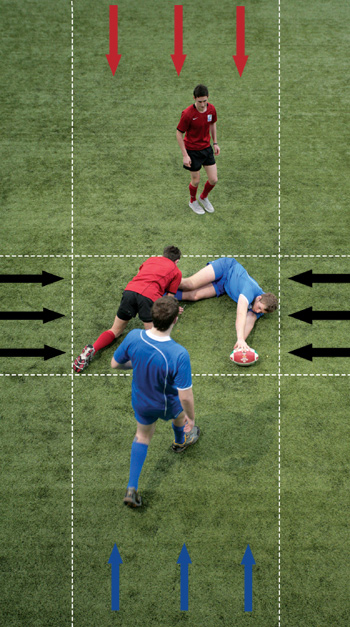The tackle
A tackle is used by the defending team to stop the attacking team moving forward and is an opportunity for the defending team to contest for possession of the ball. Competence in tackling and taking a tackle is critical in developing a safer and more enjoyable game. Recent studies from Australia and the UK have shown that 58% of injuries result from tackle situations, so it’s essential that this aspect of the Game must be coached, performed and refereed with due care and attention, with good technique and safe, appropriate practice paramount. This will enable players to become confident and competent in the tackle.
Law Definition
A tackle occurs when the ball carrier is held by one or more opponents and is brought to the ground.
Key points for players in every tackle situation
Tackler - contact with opponent(s)
- ‘Eyes up’ looking at the ball carrier to keep head in correct position
- Track the movement of the ball carrier, and get the feet close enough to make the tackle
- Prepare for contact – adopt a body position that is strong, stable and low
- Position the head behind or to one side of the ball carrier - never position the head in front of the ball carrier
- Use the arms to ‘wrap’ around the ball carrier
- Release the tackled player, get back to your feet immediately and contest for possession
Ball carrier - contact with ground
- Carry the ball in both hands
- Protect the ball - hold it tight to your chest with elbows in to your sides
- Make contact with the ground with the buttocks and then shoulder
- Don’t break your fall with your hand or the ball
- Turn towards your team and pass, place or present the ball
- Get back to your feet as soon as possible
For specific key points, see the individual tackle types below.
|
Player safety research for the tackle tells us that:
|
The safer "Eyes Up" tackling model was initiated and promoted by Trust PA in memory of Welsh player Paul-Andre Blundell - known as P.A., of Keynsham RFC in the English South West League One, whose life it might have saved.
Trust PA is a UK spinal repair charity established in P-A's memory.
Shoulder tackle - front-on |
|
|
|
|
 |
|
 |
|
 |
|
 |
|
 |
|
 |
|
Shoulder tackle - side-on |
|
 |
|
 |
|
 |
|
 |
|
 |
|
|
|
|
Smother tackle |
|
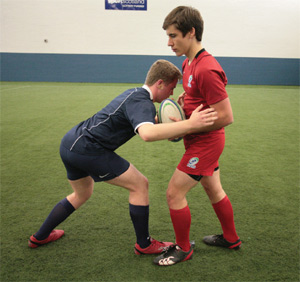 |
|
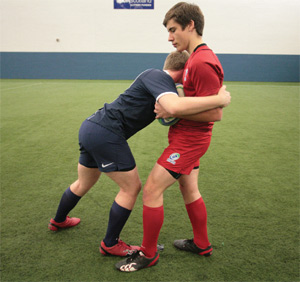 |
|
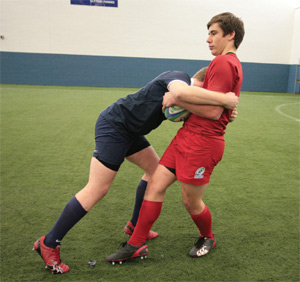 |
|
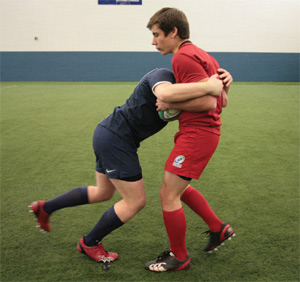 |
|
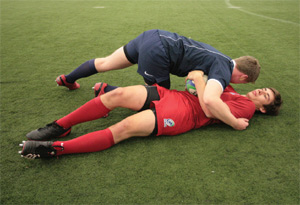 |
|
Tap tackle |
|
 |
|
 |
|
Unless the ball carrier is held after being brought to ground, then in Law, a tackle has not been made and the referee will allow open play to continue.
Tackles involving more than one tackler |
|
 |
|
 |
|
Nearly half of all tackles involve more than one tackler. The double tackle is rarely planned and is difficult to coach. It is not encouraged, particularly among young players.
Tackle from behind |
|
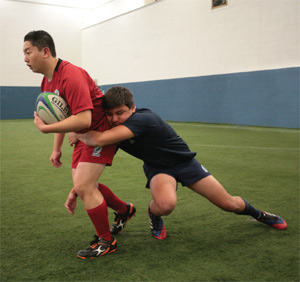 |
|
|
|
|
Tackling in a dangerous manner |
|
| All players are responsible for their actions when tackling a ball carrier and, as such, a tackler must NOT ‘tackle’ an opponent in a dangerous manner. Examples of dangerous ‘tackles’ include: | |
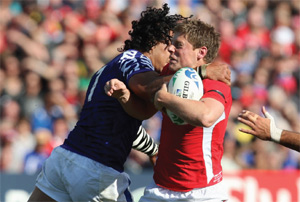 |
High contact - ‘Tackling’ above the Sternum. Please refer to: World Rugby Passport - Lower tackle height law trial introduction |
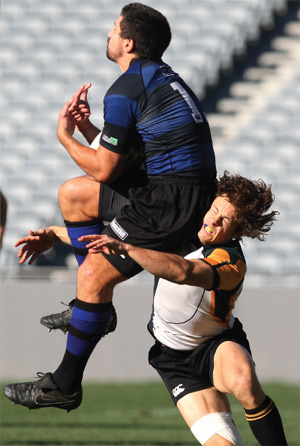 |
In the air -‘Tackling’ a player whose feet are off the ground |
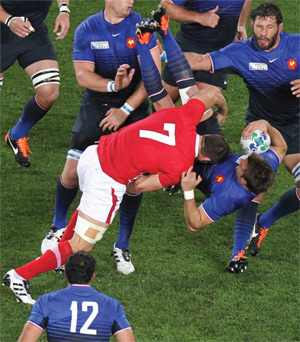 |
Spear/tip tackle -Lifting a ball carrier (opponent) from the ground and dropping that player (tipping) or driving that player (spear) onto the ground so they land on their upper body, neck or head |
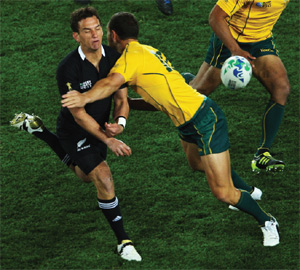 |
Late (ball gone) -‘Tackling’ a player after a pass is made |
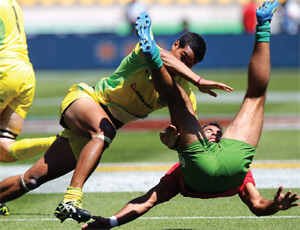 |
Early -‘Tackling’ a player without the ball |
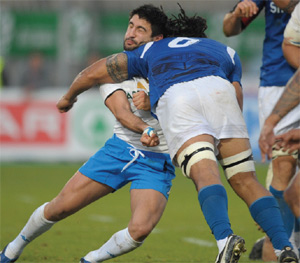 |
Charging -‘Tackling’ a ball carrier without attempting to grasp that player using hands/arms |
Arriving players |
|||
|
|||
How the tackle gate formsDuring the tackle, both players should attempt to rotate to face their own team-mates. |
|||
|
Red Team
|
 Before contact Before contact |
 Contact completed Contact completed |
Red Team
|
The tackle gate |
|||
| No player may join from here |
Red players must join from here
Blue players must join from here |
No player may join from here |
|
Coaching Tips
Poorly executed tackles tend to be the result of poor positioning by the tackler rather than poor tackle technique. Correct positioning can and should be practised. It involves the tackler closing down the ball carrier’s space and then establishing balance and stability before stepping in close with the lead foot to allow shoulder and arm contact, which should then allow leg drive in the tackle.
- Use the key points to improve the players’ tackle skills in a safe manner
- Emphasise the legal requirements in the tackle regarding use of arms (see the earlier section on dangerous tackles)
- Focus on one or two key points at a time - don’t try to coach too many key factors at once
- Observe and analyse players to highlight good practice and correct faults
- Provide positive and constructive feedback to improve players
- Construct coaching sessions to encourage progressive development, and build confidence
- An example of the tackle progression for the side-on tackle is as follows:
- Ball carrier kneel - tackler kneel (only for side-on tackle to demonstrate head position)
- Ball carrier stand - tackler kneel (encourage leg drive)
- Ball carrier walk - tackler on one knee
- Ball carrier stand - tackler squat
- Ball carrier walk - tackler squat
- Ball carrier walk - tackler walk
- Ball carrier run - tackler run - Avoid gender, size, age and experience mismatches when introducing and developing skills
- Ensure players practice in sufficient space to avoid accidental collisions with unseen players
Referee Tips
Check that:
- The tackle is made below the sternum
- The tackler uses the arms to grab and hold the ball carrier
- If the ball carrier is lifted off the ground, they are brought back to ground safely
- The tackler releases the tackled player
- The tackled player passes, places or releases the ball immediately
- Both players get to their feet
- Arriving players enter the tackle zone through the correct gate
- Arriving players remain on their feet
Watch for:
- Illegal and/or dangerous acts, which are not tackles (see the earlier section on dangerous tackles)
- Players who charge or obstruct opponents who are not near the ball
- Tackles making contact with the head or neck or which might cause damage to the neck or head - these MUST be strictly dealt with
Visit World Rugby’s Law Education web site


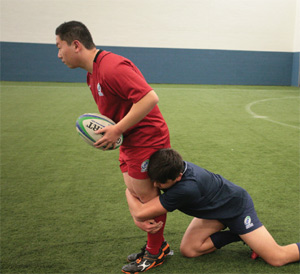
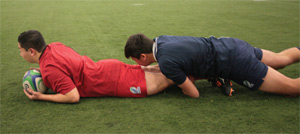

 Blue Team
Blue Team